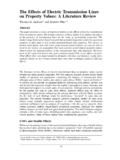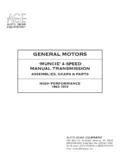Transcription of Risk of HIV transmission in discordant couples - WHO
1 Comment270 Vol 372 July 26, 2008 confi dent that there had been no breach of research integrity on the part of the authors, and that every eff ort had been made to achieve consensus on the submitted manuscript. The Lancet also sought advice from the Committee on Publication Ethics (COPE),3 who agreed with the journal s suggestion to invite Phadke to write a Correspondence letter for publication outlining her concerns and for the journal to write an accompanying Comment to document the course of among authors are one of the most diffi cult situations for editors to deal with. In this case, the editors felt and COPE agreed that all possible attempts to come to an agreement had been made. In our opinion, publication of these important data, with complete disclosure, is the best course of Pini, Sabine KleinertThe Lancet, London NW1 7BY, UK1 Six Week Extended-dose Nevirapine (SWEN) Study Team.
2 Extended-dose nevirapine to 6 weeks of age for infants to prevent hiv transmission via breastfeeding in Ethiopia, India, and Uganda: an analysis of three randomised controlled trials. Lancet 2008; 372: 300 Phadke MA, Bulakh PM, Kshirsagar NA. Nevirapine to prevent hiv transmission via breastfeeding. Lancet 2008; 372: Committee on Publication Ethics. (accessed July 17, 2008).Risk of hiv transmission in discordant couplesIn view of the fact that successful antiretroviral treat-ment of HIV dramatically reduces viraemia1 and that the risk of hiv transmission in discordant heterosexual couples depends on viral load,2 it seems remarkable how muted discussion has been of the potential role of treatment in reducing risks of infection. However, a consensus statement by the Swiss National AIDS Commission advised that after 6 months treatment, if the virus is undetectable in the plasma and in the absence of another sexually transmitted infection, the risk of transmitting HIV is has been subsequent debate on the validity and wisdom of the statement, including in today s Lancet in which David Wilson and colleagues illustrate the implications of over-optimism about reduced trans mission in discordant Using a model of the relation between viral load and transmission risk per sex act, they show how the risk of a transmission event could accumulate over many sex acts.
3 A major assumption needs to be emphasised when reviewing the predictions from this paper: the authors extrapolate the model beyond the available data, assuming that there is a continuous reduction in risk rather than a threshold below which no transmission is possible. The Swiss statement is based on the diff erent assump-tion that there is such a threshold, as was observed in a study in Rakai, Uganda, where no transmission events occurred when viral copy numbers were below 1500 copies per Unfortunately, small sample sizes mean that neither assumption is secure, and there are fewer data for men having sex with Wilson and colleagues agree with the Swiss statement is that hiv transmission will be much reduced when antiretroviral treatment suppresses plasma viral loads. They then show how combining condom use and antiretrovirals further reduces the chances of trans-mission.
4 What they do not do is compare condom use alone with suppression of viraemia through treatment. If, because of incorrect or inconsistent use, condoms are only 95% effi cacious, the safe sex implied by the use of condoms would be less safe than reducing viral loads through treatment (fi gure). Some people might be very risk averse and want to combine treatment and condoms, which, given the uncertainty over whether there is a threshold viral load that allows transmission , may be wise. Other people might have reasons for foregoing one of the protections, especially in attempts to conceive. Denying an eff ect of treatment on risk of transmission would be dishonest and futile, because well-informed patients will assume an eff ect. In counselling and advising patients about the risks of transmission , providing a balanced estimate of the risk over the course of many sex acts, as derived by Wilson and colleagues, would be better than trying to totally eliminate need to separate out the role of treatment for a couple and eff ects of treatment in the population as a whole.
5 At a population level, there has been an upsurge of risk in some communities, identifi ed by an increase in other sexually transmitted infections and an increasing incidence of HIV. However, much of this upsurge will be due to risk-taking behaviour, infl uenced indirectly by the availability of antiretrovirals, by those who are See Articles page Vol 372 July 26, 2008 271susceptible or infected without being aware of ,6 The use of antiretrovirals should directly decrease the incidence of infection, but this population-level eff ect will be limited unless diagnosis is more timely and treatment is used much earlier during an infection for public-health reasons rather than necessarily for clinical Moving treatment earlier to when CD4 cell counts fall below 350 cells per L goes some way in this direction, as do eff orts to improve rates of diagnosis in those people who are infected but unaware of their HIV.
6 9We should be concerned about the spread of other sexually transmitted infections if condoms are not used. Although trials suggest that the control of asymptomatic sexually transmitted infections has limited eff ect on the current spread of HIV,10 the situation might diff er if antiretroviral treatment was being used to prevent hiv transmission ; asymptomatic sexually transmitted infections might, through local HIV replication, reintroduce a risk of transmission in a discordant couple. In many ways, the Swiss statement3 provides the opportunity for positive public-health messages, by promoting adherence to treatment and concern over other sexually transmitted infections. The use of condoms, in addition to antiretrovirals, to further reduce risk and prevent other sexually transmitted infections can then also be promoted.
7 *Geoff rey P Garnett, Brian GazzardDepartment of Infectious Disease Epidemiology, Faculty of Medicine, Imperial College London, St Mary s Campus, London W2 1PG, UK (GPG); and Chelsea and Westminster Hospital, London, UK (BG) has consulted for GlaxoSmithKline about HSV-2 epidemiology. BG declares that he has no confl ict of Vernazza PL, Troiani L, Flepp MJ, et al. Potent antiretroviral treatment of HIV infection results in suppression of the seminal shedding of HIV. AIDS 2000; 14: 117 Quinn TC, Wawer Mj, Sewankambo N, et al. Viral load and heterosexual transmission of human immunodefi ciency virus type 1. N Engl J Med 2000; 342: 921 Vernazza P, Hirschel B, Bernasconi E, Flepp M. Les personnes seropositives ne souff rant d aucune autre MST et suivant un traitment antiretroviral effi cie ne transmettent pas le VIH par voie sexuelle. Bull Med Suisses 2008; 89: 165 Wilson DP, Law MG, Grulich AE, Cooper DA, Kaldor JM.
8 Relation between HIV viral load and infectiousness: a model-based analysis. Lancet 2008; 372: 314 Baggaley RF, Garnett GP, Ferguson NM. Modelling the impact of antiviral use in resource poor settings. PLoS Med 2006; 3: Elford J. Changing patterns of sex behaviour in the era of highly active antiretroviral therapy. Curr Opin Infect Dis 2006; 19: 2 Bezemer D, de Wolf F, Boerlijst MC, et al. A resurgent HIV-1 epidemic among men who have sex with men in the era of potent antiretroviral therapy. AIDS 2008; 31: 1071 Branson BM, Handsfi eld HH, Lampe MA, et al. Revised recommendations for HIV testing of adults, adolescents, and pregnant women in health-care settings. MMWR Recomm Rep 2006; 55: 1 Donaldson L, Beasley C. Improving the detection and diagnosis of HIV in non-HIV specialities including primary care. Sept 13, 2007. (accessed July 16, 2008).10 Gray RH, Wawer MJ.
9 Reassessing the hypothesis on STI control for HIV prevention. Lancet 2008; 371: 2064 0 10 20 30 40 50 60 70 couples in whom transmission occurs (%) Treatment alone 100% condom use 80% condom use Combined treatment and 100% condom use Figure: transmission risk over 100 sex acts in discordant male couple Derived with model in reference in children: a disaster in the makingThe Countdown to 2015 meeting earlier this year identifi ed HIV/AIDS as a factor or a leading cause of preventable death in children in the 42 countries with lack of progress towards the target of Millennium Development Goal The identifi cation of HIV/AIDS as a leading cause of death is a particular tragedy because HIV/AIDS in children is almost entirely preventable. 90% of childhood HIV infections now occur in sub-Saharan Without treatment, HIV in children is lethal.
10 There are large and unacceptable inequities in access to HIV prevention and treatment for 420 000 children worldwide were newly infected with HIV in 2007; 330 000 children died of AIDS, mostly in sub-Saharan In the 2008 Countdown statistics, high HIV prevalence was associated with the highest rates of child mortality in those aged under 5 years and
















